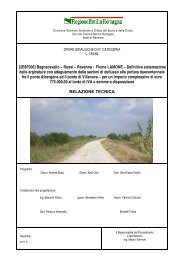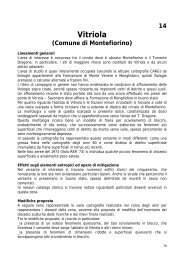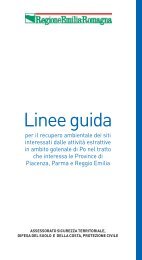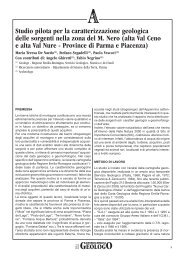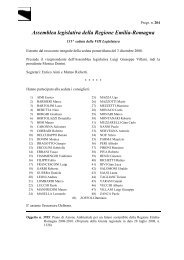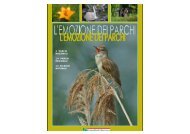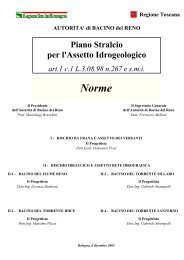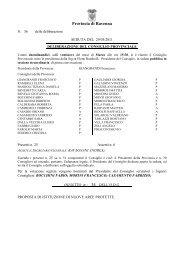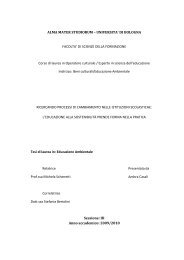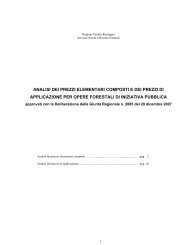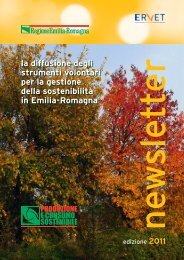air, water and soil quality qualité - ER Ambiente - Regione Emilia ...
air, water and soil quality qualité - ER Ambiente - Regione Emilia ...
air, water and soil quality qualité - ER Ambiente - Regione Emilia ...
You also want an ePaper? Increase the reach of your titles
YUMPU automatically turns print PDFs into web optimized ePapers that Google loves.
Water soluble metals can easily be mobilized <strong>and</strong> may considered as highly available<br />
(Seguin et al., 2004). Extraction of pore <strong>water</strong>, leaching test <strong>and</strong> DGT are selected<br />
methods for assessment of bioavailability of heavy metals in <strong>soil</strong> solution (ISO, 2008).<br />
In addition the National Institutes for environmental protection (ISPRA, Istituto Superiore<br />
per la Protezione e la Ricerca Ambientale) <strong>and</strong> health (ISS, Istituto Superiore di<br />
Sanità) recommended a <strong>soil</strong> <strong>water</strong> extraction as a method to determine the solid-liquid<br />
partition coefficient of <strong>soil</strong> contaminants for healthy-environmental risk assessment<br />
(APAT-ISS, 2007).<br />
Adsorption-desorption processes are important controls on the concentration of metals<br />
in the <strong>soil</strong> solution. From this point of view, study on sorption-desorption reactions of<br />
heavy metals showed that low-molecular-weight-organic-acids (LMWOAs) are involved<br />
in many interactions with the physicochemical properties of <strong>soil</strong>s influencing<br />
desorption of metal cations by complexation (Harter, 1983; Bruemmer et al., 1988;<br />
Pohlman <strong>and</strong> McColl, 1988; Fox, 1995; Drever <strong>and</strong> Stilligs, 1997; Qin et al., 2004).<br />
Soil solution LMWOAs, mainly aliphatic mono-, di- <strong>and</strong> tricarboxylic acids, originate<br />
from several biotic sources (Strobel, 2001). Major sources are from decomposition of<br />
<strong>soil</strong> organic matter in the upper <strong>soil</strong> horizons (Christ <strong>and</strong> David, 1996; Evans, 1998),<br />
microbial metabolites <strong>and</strong> plant roots exudates (Jones, 1998; Ma <strong>and</strong> Miyasaka, 1998).<br />
Root exudation of chelating aliphatic LMWOAs improves weathering <strong>and</strong> release of<br />
cations from <strong>soil</strong> minerals <strong>and</strong> increase the availability of nutrient cations in the<br />
rhizosphere of plants <strong>and</strong> fungi (Leyval <strong>and</strong> Berthelin, 1991; Marschner <strong>and</strong> Römheld,<br />
1994). In order to mimic <strong>soil</strong> solution levels of heavy metals a single extraction procedure<br />
with LMWOAs was investigated to estimate metal phytoavailability (Shan et al,<br />
2003; Wang et al., 2003; Feng et al., 2005). The authors observed better correlations<br />
between plant uptake <strong>and</strong> extractable levels by LMWOAs extractant in comparison<br />
with other one-step extraction methods <strong>and</strong> attributed to LMWOAs the extraction of<br />
the labile fractions in <strong>soil</strong> solution which are responsible for the short-term available<br />
pool.<br />
The main objectives of this study were to assess spatial changes of metals in surface<br />
<strong>soil</strong>s in the urban environment of Ravenna <strong>and</strong> to correlate them with <strong>soil</strong> physicochemical<br />
properties <strong>and</strong> metal content in plant leaves simultaneously sampled. Specifically<br />
in this paper we reported the preliminary results about the relationship between<br />
l<strong>and</strong> use <strong>and</strong> management <strong>and</strong> chemical fractionation of metals in the top<strong>soil</strong> using<br />
single extractions. Further, single extractions were compared to aqua regia digestion<br />
by bivariate correlation.<br />
Materials <strong>and</strong> methods<br />
Three location types of different environmental impact were identified in the district of<br />
Ravenna, Italy: a city park mainly exposed to vehicular traffic; a suburban pinewood of<br />
naturalistic importance at 10 km north of the city surrounded by industrial infrastructures<br />
<strong>and</strong> rural arable fields to the east of Ravenna city. In October 2008 nine pinewood,<br />
two city park, <strong>and</strong> two arable <strong>soil</strong> profiles were selected <strong>and</strong> sampled accordingly<br />
to pedogenetic horizons. Developed on the same parent material, the thirteen <strong>soil</strong><br />
152



